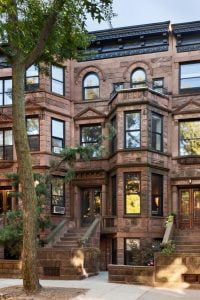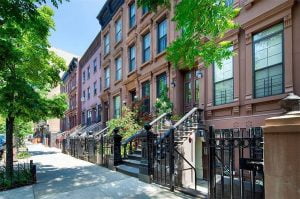The Complete Guide 202 for Buying a Townhouse in NYC
Go Back To Previous PageWhen prospective home buyers want to buy property in New York City, it’s usually a co-op or condo apartment. However, some buyers also look at townhomes for sale, just as they purchased a house in the suburbs. Buying a townhouse: what does it take, and what pros and cons? Despite its price, a townhouse offers many good things. These include privacy and the rare opportunity to own outdoor space. These features appeal to couples with children or who are in the process of starting a family. How much is a townhouse for sale in NYC? Where are the most beautiful townhouses for sale in Manhattan, NYC?
buyers also look at townhomes for sale, just as they purchased a house in the suburbs. Buying a townhouse: what does it take, and what pros and cons? Despite its price, a townhouse offers many good things. These include privacy and the rare opportunity to own outdoor space. These features appeal to couples with children or who are in the process of starting a family. How much is a townhouse for sale in NYC? Where are the most beautiful townhouses for sale in Manhattan, NYC?
Real estate investors are also turning to townhouses because they can convert them into rental properties. Townhouses are unique, often landmarks with historical details you can’t find anywhere else in New York City.
Homebuyers covet them because they are rare. And those who live in them enjoy vertical living and the ability to make renovations without getting board approval.
What if you wanted to rent a portion of your home? We’ll tell you everything you need to know about townhouses in New York City.
Townhouses have been coveted Since the Pandemic.
Townhouses outperform co-ops and condos as New York City’s real estate market has reawakened since the pandemic.
In urban areas, homebuyers living in apartments want their own space to avoid contracting Covid-19 in common areas.
In a co-op or condo building, you share germs found in a lobby, elevator, staircase, and hallway with countless neighbors.
What is a Townhouse?
A townhouse is a multi-floor private home. It typically shares walls with an adjacent building, often another townhouse. It has an entrance and is usually found in New York City and Brooklyn neighborhoods.
A townhouse also eliminates neighbors above and below you when you live in an apartment unit, which means you don’t have to worry about those who live beneath you who keep complaining that you’re making too much noise.
1. Types of townhouses
There are brownstone, limestone, and brick townhouses. The most popular townhouse is the brownstone, and the iconic brownstone is a brick row home finished with reddish-brown sandstone.
home finished with reddish-brown sandstone.
The second most popular townhouse is the brick townhouse with a brick façade. Brownstone and brick homes can be more than 200 years old and built in the 1800s or early 1900s, giving them a historic appearance.
2. The Trade-Off When Buying a Townhouse
Unlike co-op or condo owners, townhomes don’t come with amenities. If locked out, you don’t get a white-glove doorman to receive your packages or keep spare keys. And that superintendent and whom you rely on to change a light bulb from a light fixture you can’t reach?
Well, you have to give up what they each offer: convenience. You can also rent first with the option to buy later.
Also, pay attention to air rights.
Is Townhouse Maintenance Higher Than a Condo or Co-op Maintenance?
A condo or co-op requires you to pay monthly common or maintenance charges. While prices vary for each apartment, they are often expensive and cost around $20,000 annually, and that HOA fee comes with HOA rules.
1. A townhouse is more expensive when it comes to maintenance.
The owner is responsible for every part of the house. This includes checking the boiler and HVAC, the furnace, the plumbing, the roof, and the driveway, if any. All of these are costly to maintain and repair.
If the water heater breaks or the roof develops a leak or needs replacement, you will also have to pay for these expenses. You must also sweat the small stuff, like maintaining the front yard grass, shoveling snow on the steps, salting your icy sloop, taking out your garbage, and putting it on the curb.
2. You also need to ensure your sidewalk is in good condition.
As per New York City guidelines outlined on the NY.gov site, you are responsible if someone slips on ice on your sidewalk and gets injured. And if a tree in front of your townhouse has a root that comes up and lifts part of the sidewalk, you will also be responsible if someone trips over it.
In short, townhouses can be expensive to maintain. On the other hand, if you want to renovate your townhouse, like updating the kitchen, you don’t need board approval as you do in a co-op or condo.
Not all Townhomes are the Same Size
Brokers describe New York, NY townhouse square footage in width and depth. The width of some townhouses ranges from 13 to 25 feet, while others run between 16 and 20 feet wide. Homes wider than 18 feet are precious real estate because you get more house space.
Rare homes wider than 20 feet are called “trophy” townhouses. Some real estate agents refer to more expansive townhouses as “mansions.”
Buying a Single-Family vs. Multi-Family Townhouse
1. Buying a single-family townhouse in NYC
A single-family townhouse can only be occupied by one family. The owner can rent the entire house for rental income, but only one family can live in it again.
If you’re lucky enough to buy your townhouse in New York City, then you’ll be one of the few New Yorkers who will be able to have no neighbors within your building or board members to deal with. You’ll never have to worry about internal politics or co-op board fines and rules. Given how small-minded some people can be, it’s a great relief to be the master of your own house.
However, buying a townhouse in NYC resembles buying your typical, free-standing house in the suburbs. You won’t have a managing agent to manage the property, so you’ll be responsible for all the maintenance and repairs. That means you’ll be responsible for calling and hiring contractors to fix the boiler, repair the roof, etc. Furthermore, you’ll have to closely monitor how fast your property taxes are rising.
Buying a townhouse in NYC may mean hiring a tax certiorari firm or going through the complex process yourself. You should double-check the property’s Certificate of Occupancy (C of O or CO) to confirm that the building designates single-family occupancy. Remember that a townhouse or brownstone is a property style and has nothing to do with how many legal units the building consists of.
2. Buying a Multi-Family Townhouse in NYC
A multi-family townhouse is a home containing at least three dwelling units, and a building with two dwelling units is a two-family residence. Often smaller, two-family townhouses will have an owner’s duplex or triplex at the top and a garden apartment or a duplex at the bottom to rent out.
If you buy a multi-family townhouse, you can convert it to a single-family house. Also, you can buy a multi-family home as an investment property and live in the townhouse while you have tenants from which you can collect rent.
Or you can rent out the entire townhouse as an investment property, which allows you to collect more rent and may even pay your monthly mortgage in whole or part. Regardless of the layout, living above your tenants is generally better, making you less likely to be disturbed by noise. Besides earning rental income from a relatively stable asset vs. the stock market, buying investment property in NYC has many other great benefits, such as the ability to expense almost any costs associated with the property.
Furthermore, residential property investors can fully depreciate their cost basis over 27.5 years.
Do Your Due Diligence by Studying the DOB Site
The first thing you should do when contemplating buying a townhouse is to check the Department of Buildings website. The DOB features records of construction permits, code, and zoning violations.
Potential homebuyers should look for open permits or violations and court records. The buyer can find out if there are any existing liens or judgments and property tax rolls to see if there are any delinquencies. If any of these things are true, you should have them resolved by the seller.
DOB and certificate of occupancy (CO)
It would help if you also turned to the DOB for the certificate of occupancy (CO). Every residential building in New York City requires one that outlines how a dwelling is used. The DOB is where you obtain a construction permit if you plan on remodeling or changing the house’s structure.
Keep in mind that you need a new CO if you make Renos. Also, your CO requires a change if you turn a multi-unit townhouse into a single-occupancy one. Also, visit the DOB to determine which category your townhouse falls under.
For example, it may look like you’re purchasing a multi-family house during closing or before getting mortgage approval. But it may be, by law, a single-family house.
Since the DOB keeps records of the legal use of a townhouse, you can discover which properties have been converted from single-family homes. That can cause problems when you secure a mortgage loan or insure the townhouse.
Does Your New Townhouse Need A Home Inspection?
A home inspection visually examines the physical structure of a house, a townhouse, a condo, or a co-op.
A licensed inspector evaluates the townhouse and can give you a report on any defects in the home. The inspector looks at both the interior and exterior of the townhouse and the area surrounding it in case of hazardous issues they may come across.
Your mortgage lender will often require you to hire a home inspector. Even so, it would always help to have your inspector uncover any encroachments or title issues before closing.
Structural Components of the Townhouse
A review of the townhouse’s structural components is critical. A qualified engineer, not an inspector, should be responsible for the survey, as many New York City townhouses are historical buildings. Because many structural components are listed above, you will use the engineer the most when determining the inspector. Any blemish will be costly and may damage the townhouse owner’s ability to finance and insure the building.
Note that the prospective townhouse owner is solely responsible for paying the inspector or surveyor. While the bill will be high, you can pay the costs with your closing costs.
What to Do if Your Inspector Uncovers Damages or Costly Repairs
If repairs like a leaky roof, plumbing, or electrical wiring issues need to be made, you should ask the seller to repair them before closing. Or you can ask for a credit that can be applied against the purchase price. If the seller balks at either, you can walk away from purchasing a townhouse if your contract stipulates that you’re entitled to a way out.
The two most costly repairs you must consider are the roof and the townhouse’s façade.
1. The Roof
The two most common roof issues are leaks and the separation of roof parts. A new roof or its repair is costly and time-consuming. So, before you buy a townhome, have it inspected by an engineer. (A licensed inspector usually won’t touch the roof.)
If the roof has a problem, have the seller fix it. The seller can also report whether the roof has been recently repaired or has some existing issues.
2. The Facade
If you purchase a brownstone, note that it’s a porous material that can cause erosion and decay because of environmental factors like moisture. If these happen, you must renovate the façade to ensure its structural integrity and appearance. According to Business Insider, a complete façade replacement can start at $70,000 and go up to six figures for a three or four-story townhouse.
How Do You Know the Value of Your Townhouse?
The value of your townhouse can be astronomical, in the high millions, depending on where it is located. It depends on how the townhouse backs up to the townhouse behind it, adjacent to the other townhouses, and overall the townhouses across the street.
The value of a townhouse increases in price if it’s on a block with rows of other townhouses on both sides of the street. And if the townhouses have good curb appeal, such as tree-lined streets and quaint sidewalks to walk your dog or mingle on, you’re buying in a desirable area.
Real estate agents and brokers unanimously agree that what brings down the value of a townhouse is if the townhouse is on the same street as a firehouse, a police department, or any school. The reason is that these institutions can bring about traffic and increase the noise level. You can find the most desirable townhouses in the 70s in the Upper West Side, Greenwich Village, the West Village, and the Upper East Side. Also desirable are townhouses in Brooklyn, including Brooklyn Heights, Carroll Gardens, and Cobble Hill.
How to Make Money After Buying Your First Townhouse
Home buying as an investment property is a great way to make money. But how do you rent out the townhouse you just bought? And are you going to live there while having tenants?
Before you start, determine how much you want to charge for rent. It should depend on the interest rate of your new mortgage, maintenance costs, and licensing fees. More than anything, your rent will be based on comps in the surrounding area. That’s one of the reasons why buying a townhouse in Manhattan, NYC, is a good neighborhood essential.
1. The Lease Agreement
You should then make up a lease agreement for a prospective tenant to protect you if something negative occurs, such as the tenant failing to rent or always having noisy parties. This is the most important thing you should do, so always run it by an attorney to cover the fine points you may miss.
2. You Should Always Screen Tenants after Buying a Townhouse.
The tenant should respect your property. If he doesn’t, he’ll likely be a bad neighbor and not care about the conditions of the rooms he’s renting. First, do a credit and background check. Then, get references from previous landlords and work.
Lastly, interview the prospective tenant thoroughly. If the prospective tenant has a remarkable renting history and has never missed a monthly rent payment, that tenant is a keeper.
3. Be a Good Superintendent
You become a landlord the moment you start renting your townhouse. As such, you must provide tenants with an excellent superintendent to fix potential problems. If you’re not handy and don’t know how to unclog a toilet, hire a maintenance “floater” or a communal super who usually works for the entire rowhouse block.
This is a necessity, as tenants have rights, too. Your rental space must always have hot and cold water, and the plumbing must work. You must also resolve mold problems, peeling paint, rodents, and bedbugs.


